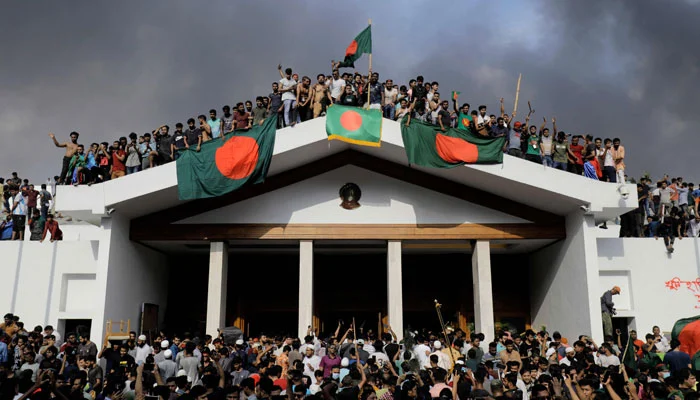DHAKA: The grand residence once occupied by Bangladesh’s ousted Prime Minister Sheikh Hasina’s is being repurposed into a museum that aims to serve as a powerful reminder of her controversial rule and the mass uprising that led to her downfall.
The Ganabhaban palace in Dhaka, a former seat of power and now a symbol of authoritarianism, was stormed by thousands of protesters after Hasina fled the country via helicopter to India on August 5, 2024. The image of jubilant demonstrators waving flags from the rooftop quickly became a defining snapshot of a historic student-led movement that toppled her 15-year rule.
A year on, Bangladesh remains politically unsettled. Yet, the conversion of Ganabhaban into a museum is being presented as a national reckoning—an effort to preserve the memory of resistance and warn future generations.
Graffiti left by protesters remains untouched across its walls: “Freedom,” “We want justice,” and “Killer Hasina,” among other messages, are now protected as part of the historical record.
A Dark Chapter
According to the United Nations, Hasina’s final months in power were marked by sweeping human rights violations, including mass detentions and extrajudicial killings. Nearly 1,400 people lost their lives between July and August 2024, as her regime attempted to suppress dissent.
Now 77, Hasina has refused to comply with court summons for her ongoing trial in Dhaka, where she faces charges related to crimes against humanity—allegations she continues to deny.
“This museum will preserve the memories of her misrule and the people’s rage that ultimately unseated her,” said Nobel Laureate Muhammad Yunus, 85, who currently heads the caretaker government until elections scheduled for early 2026.
“A Symbol of Fascism”
Rights activist and photojournalist Mosfiqur Rahman Johan, who participated in the palace takeover, recalled the surreal scenes—protesters swimming in Hasina’s private lake, eating from the kitchen, and dancing in her bedroom.
“For us, Ganabhaban is a symbol of fascism, a monument to an autocratic regime,” he said. “This museum will visualize the pain and resistance of the people.”
Originally built by Hasina’s father, Sheikh Mujibur Rahman—Bangladesh’s founding leader—the palace became her official residence during her lengthy tenure in power.
Museum to Document Resistance and Repression
Curator Tanzim Wahab explained that the museum will feature films, photographs, and personal artifacts of slain protesters. Names of those killed during Hasina’s broader rule will be inscribed on plaques.
“The purpose isn’t just historical. It’s about reflection—looking back at years of oppression and igniting conversations about democracy,” Wahab said. The museum will also include interactive exhibits, animations, and reconstructions of the cramped cells where political opponents were imprisoned.
“We want this to be a space where young people engage in discussions about democratic values and the future of Bangladesh,” he added.
Struggle for Democracy Continues
Yunus has pledged to reinforce democratic institutions before the 2026 polls, but progress has been slow amid political infighting and competing agendas.
Human Rights Watch has warned that the interim administration faces enormous obstacles, including a powerful, unreformed security apparatus, threats from extremist factions, and political groups bent on vengeance rather than justice.
As the Ganabhaban transformation moves ahead, many other remnants of Hasina’s era have been destroyed. Statues of her father have been toppled, portraits burned, and even Sheikh Mujibur Rahman’s former home—once a museum curated by Hasina—was demolished by demonstrators using construction equipment.
“When a dictatorship falls, its sanctuaries must fall too,” said Muhibullah Al Mashnun, a 23-year-old student who helped tear down the residence. “Those were monuments to tyranny. To move forward, we had to remove them.”
For the latest news, follow us on Facebook DAILY HAYAT - Mirpur A.J.K













